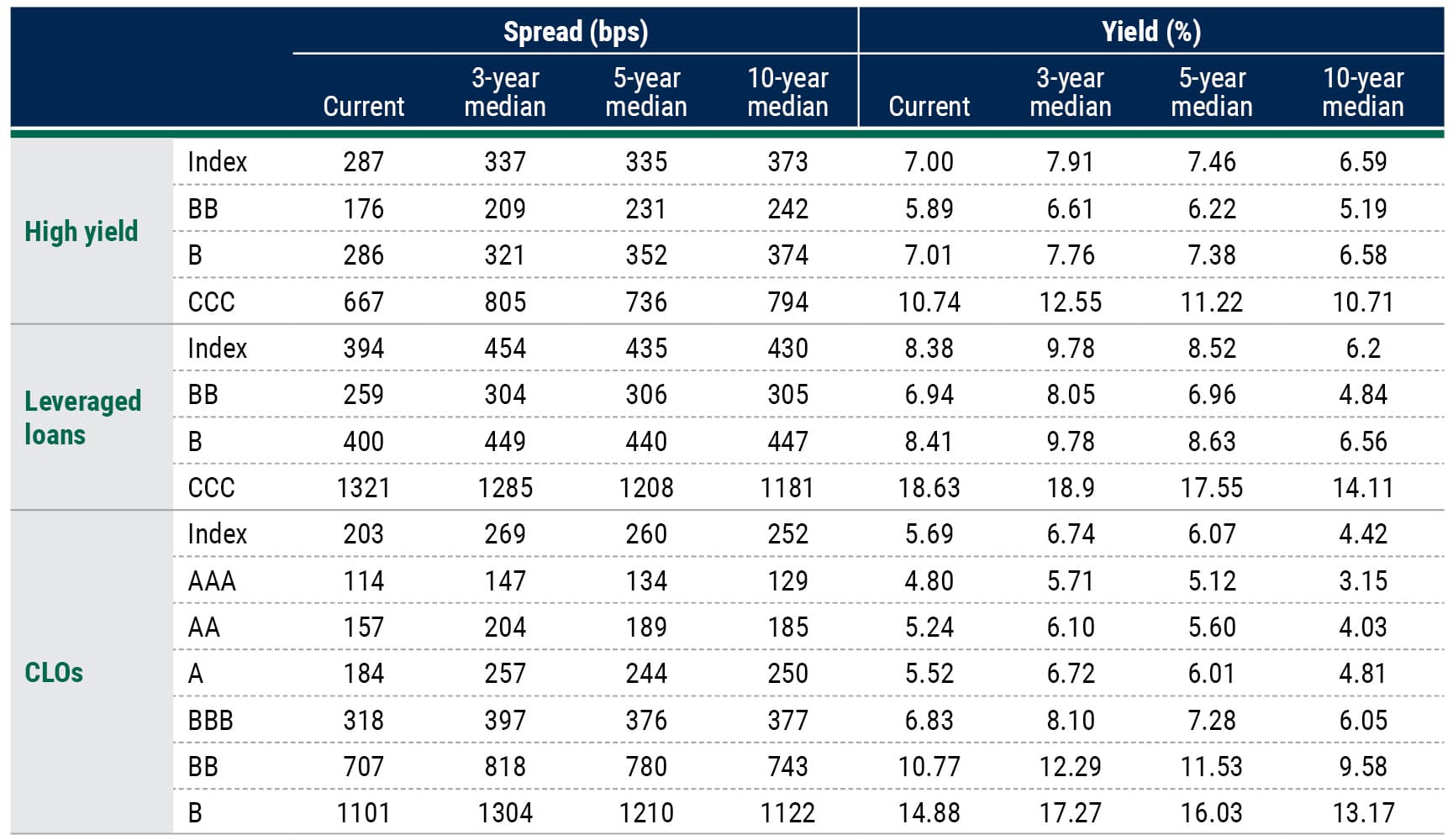Leveraged Finance Asset Allocation Insights: Tariff Effects Emerge

Steven Oh, CFA
Global Head of Credit and Fixed Income, Co-Head of Leveraged Finance

John Yovanovic, CFA
Co-Head of Leveraged Finance

Kevin Wolfson
Portfolio Manager, US Leveraged Loans and CLO Management

Laila Kollmorgen, CFA
Global Head of CLO Tranche Investments, Portfolio Manager

Jeremy H. Burton, CFA
Portfolio Manager, US High Yield and Leveraged Loans

Andrew Karlsberg, CFA
Portfolio Risk Manager and Investment Strategist, Leveraged Finance

Jonathan Kramer, CFA
Fixed Income Product Specialist, Leveraged Finance

Evan Burke
Assistant Portfolio Manager, US Leveraged Loans

Komal Shahzad, CFA
CLO Tranche Analyst
Tariff-related challenges continue to reveal themselves in second-quarter earnings results, particularly in sectors including packaging/paper, retail, chemicals, and capital goods. Fewer companies are managing to pass these costs on to customers than in the previous quarter, indicating weakening demand, and midsized companies are feeling the biggest impact.
Overall, we expect positive, carry-based total returns for high yield bonds (but muted excess returns) and believe defaults could bleed a bit higher in 2026. We maintain a neutral portfolio stance following recent spread tightening and currently favor BB/B rated segments over lower-quality segments.
Leveraged loan issuer fundamentals remain relatively stable, but performance for the asset class could be susceptible to top-down views on the economy’s near-term trajectory. If loan spreads were to widen more broadly, we would expect increased opportunities to generate alpha through credit selection.
We believe CLOs have attractive total return potential relative to other equivalently rated fixed income assets amid current conditions. CLO ETFs have now seen 16 consecutive weeks of inflows, with institutional demand also remaining robust, and while risks appear broadly balanced, tight valuations tilt us toward an incrementally more defensive portfolio bias.

Tariff-related challenges continue to affect results coming out of the second-quarter earnings season, especially in sectors like packaging/paper, retail, chemicals, and capital goods. Fewer companies are managing to pass these costs on to customers than in the previous quarter, indicating weakening demand. Midsized companies are feeling the tariff impact most acutely.
High yield (HY) issuers have shown slight improvements in their balance sheets and better-than-expected revenue growth, though profits are under pressure. Loan issuers, on the other hand, have seen a stronger recovery in both revenue and EBITDA since the first quarter, despite a modest decline in leverage and coverage metrics. Sector performance has been uneven. Technology and capital goods have led growth in both revenue and profits among high yield and loan issuers, while energy and chemicals have lagged due to ongoing tariff pressures. Overall, the second quarter has been marked by selective strength, with AI and infrastructure-related sectors performing well despite challenges, while commodity-based sectors continue to struggle.
Looking to the last two quarters of 2025, macroeconomic forecasts suggest only minor changes in revenue and EBITDA growth. However, we see risks of further declines as companies begin to feel the full effects of tariffs and deal with the consequences of earlier sales being pulled forward. Resilient growth has supported tight spreads, causing us to reduce exposure to some of the lower-rated segments of the high yield and loan markets. Now that the slowdown is more visible, we do not expect further spread tightening and see potential for moderate spread widening. Any spread widening will likely remain contained as long as the cycle does not tip into recession. We expect growth to decelerate further, leading the Federal Reserve to restart its easing cycle, and after some angst, we think the Fed will succeed in rebooting 2026 growth.
Portfolios are moderately positioned in terms of overall beta risk, and we instead favor adding incremental value via issuer and security selection. We continue to find attractive opportunities in both the bank loan and high yield markets even though we view both as fairly valued at the overall asset class level. While we believe CLOs’ total return potential looks attractive relative to similarly rated fixed income assets, tight valuations tilt us toward an incrementally more defensive portfolio bias.
Key Data

Source: Bloomberg as of 20 August 2025. High yield represented by the Bloomberg US Corporate High Yield Index; spread is OAS and yield is yield-to-worst. Leveraged loans represented by the Morningstar LSTA Leveraged Loan Index; spread is spread-to-maturity and yield is yield-to-maturity. CLOs represented by the JPM Post-Crisis CLOIE; spread is discount margin to worst and yield is yield-to-worst. Methodologies used differ between asset classes to account for differences in characteristics, including, but not limited to, call protection, reference rate, cash flows, coupon rates, and embedded options.
High Yield Bonds
Overall, we expect positive, carry-based total returns for high yield bonds (but muted excess returns) and believe defaults could bleed a bit higher in 2026. We maintain a neutral portfolio stance following recent spread tightening and currently favor BB/B rated segments over lower-quality segments.
Overall second-quarter earnings results and guidance have been positive, especially from the industrials and services sectors. Consumer, media, and chemicals have issued the weakest outlooks. Nearly three times as many high yield issuers have exceeded EBITDA expectations as have missed. Inflationary concerns were flagged by 29% of companies, a decline from 41% in the first quarter but up from 18% in fourth-quarter 2024. Additionally, 23% have raised warnings about tariffs.1
On the macro side, core US Consumer Price Index (CPI) inflation rose 0.3% month-over-month (and 3.1% year-over- year), with tariff-related price increases showing up but less sharply than anticipated. Meanwhile, US Producer Price Index (PPI) inflation surprised to the upside, jumping 0.9% in July for both headline and core figures, pushing annual inflation up by more than a full percentage point. In his much-anticipated speech at the Fed’s annual Jackson Hole meeting, Jerome Powell noted that “the baseline outlook and the shifting balance of risks may warrant adjusting our policy stance.” These remarks bolstered investor expectations of rate cuts in the last four months of 2025.
Fundamentals are still supportive and the default backdrop remains benign. The last-12-month (LTM) par-weighted default rate decreased slightly in July, to 1.37%/0.40% (with and without distressed exchanges). The par-weighted upgrade/downgrade ratio was positive in July, at 1.91 (or 1.08 by issuer), versus 1.16 (0.93 by issuer) year to date. New issuance was strong at $37.5 billion in July, continuing the trend we saw in May and June. Issuance was nearly balanced between the BB and B tiers, and we are still seeing very little CCC issuance. Fund flows were positive in July for the third consecutive month, at $2 billion of inflows.2 Capital markets have remained active so far in August, with issuance totaling $25.7 billion through the 15th, including $9.8 billion ex refi (see chart below).
High yield spreads are now firmly inside of 300 basis points (bps), with lower-rated segments outperforming so far in the third quarter. CCC spreads have tightened significantly since the tariff-induced selloff in April but are still roughly 150 bps wider than January-February levels. At current spreads, the market is once again pricing in something between a continuation of growth and a modest slowdown, without a lot of room for error. Looking ahead, on the policy front, the market reacted positively to the passage of the OBBBA and has not seemed too concerned about the long list of tariff letters sent by President Trump. The final Senate version of the OBBBA was less negative than some earlier versions with respect to targeted sectors (e.g., healthcare) that had been volatile in the leadup to the bill’s passage. We favor moderate positioning from an overall risk standpoint and a selective approach among lower-rated segments of the market.
Capital Markets Remain Active, With Issuance Exceeding Seasonal Norms

Source: JP Morgan data shown is for US Corporate High Yield Bond issuance from 1 August to 22 August 2025 and the average level for August over the calendar years from 2010 to 2024.
Leveraged Loans
Loan issuer fundamentals remain relatively stable, but performance for the asset class could be susceptible to top-down views on the economy’s near-term trajectory. In the event that loan spreads reset wider more broadly, we would expect increased opportunities to generate alpha through credit selection.
The recent wave of repricings/refinancings has helped to further buttress bank loan issuer fundamentals, and second-quarter earnings trends appear to be outpacing expectations. That said, some loans from credits that have reported disappointing earnings have been penalized, with trading levels gapping lower. In the near term, investors’ focus will likely shift from earnings to a top-down emphasis on upcoming economic data – an effort to gauge the second-order effects of rising effective tariff rates and tighter immigration policy on economic growth and inflation, balanced against the pro-growth components of the OBBBA. Evidence of deteriorating trends in the labor market and consumer spending could exacerbate concerns about the trajectory of the economy. With the percentage of the Morningstar LSTA Leveraged Loan Index rated B- and below near the historical peak (see chart below), loan spreads could be more susceptible to growth-scare narratives that spur elevated volatility within lower rating tiers.
Similar technical trends will likely prevail in the loan market in the near term but could err toward less supportive of loan prices on the margin. Wider market spreads for loans versus the recent trough paired with lower CLO liability spreads have improved the CLO equity arbitrage; however, internal rates of return (IRRs) remain at levels unlikely to drive a material increase in new CLO issuance. If economic conditions remain stable, we could see another wave of opportunistic transactions that weigh on loan prices. In addition, any combination of the onset of rate cuts or economic growth concerns could prompt net outflows from retail loan funds.
From a yield perspective, loans will remain attractive relative to historical levels in the near term, but with loan spreads still trading near recent lows and almost a full rate cut finally priced in for the next Fed meeting, valuations will likely be a smaller driver of performance than fundamental and technical factors in the near to medium term.
The Percentage of Leveraged Loans Rated B- and Below Is Near the Historical Peak
Loans rated B- and below

Source: Pitchbook, Morningstar Leveraged Loan Index as of 25 August 2025. Excludes loans rated NR.
CLOs
We believe CLOs have attractive total return potential relative to other equivalently rated fixed income assets amid current conditions. CLO ETFs have now seen 16 consecutive weeks of inflows, and institutional demand also remains robust. We believe risks are broadly balanced, with both positive and negative shocks likely in the coming months, but tight valuations tilt us toward an incrementally more defensive portfolio bias.
The market has stabilized since the back-and-forth tariff escalation and de-escalation in April, with spreads tightening materially off the wides and prices rallying back to levels seen in late February and mid-March, when most of the market was pricing above par. CLOs have generated strong total returns over this period, with YTD returns positive across the capital stack. After a brief period of underperformance from April to mid-May, below-investment-grade tranches are now the top-performing part of the capital stack. CLO AAA secondary spreads are currently S+118, and CLO BBB spreads are S+250, both tighter than levels coming into 2025.3
Despite tighter CLO debt spreads, CLO arbitrage remains under pressure, driven by ongoing loan repricing and lower CLO weighted average spreads, creating some difficulties for managers without captive equity funds to issue new deals. The CLO market also appears to be slowing into the end of August as many managers go on summer holiday. These trends could put pressure on issuance in the near term. However, CLO redemption volumes have reached $30 billion, which is providing the needed assets for new issue CLOs, given slow M&A and leveraged buyout activity.4 Overall, gross issuance of $134 billion remains ahead of 2024 levels ($123 billion) year-to-date,5 and we expect issuance to remain strong for the rest of the year.
On the demand side, CLO exchange traded fund (ETF) flows remain strong, as a more dovish Federal Reserve has not diminished retail appetite for CLOs. CLO ETFs have now seen 16 consecutive weeks of inflows, with YTD inflows surpassing $12 billion and total CLO ETF assets under management now above $35 billion.6 Institutional demand also remains robust. Based on SNL data and company filings, US banks increased their CLO holdings by over $5 billion in the second quarter to $185 billion, although this is $5 billion lower year-over- year.7 Japanese holdings also increased, although this trend is expected to weaken going forward given relative value opportunities and high redemption volumes, with a particular increase in redemptions expected for the 2018 and 2019 vintages.
US CLO ETF Assets Under Management Keep Rising

Source: BofA Global Research as of 22 August 2025.
While we do not expect significant spread compression from here, we believe returns will be driven by yield going forward. We think CLOs have attractive total return potential relative to other equivalently rated fixed income assets under these conditions. That said, roller-coaster trade dynamics and other currents will keep markets fluid, and we expect to see both positive shocks, in the form of deal announcements or teases, and negative ones, such as more aggressive policies or deal disappointments. Despite likely headline-driven volatility both ways in the coming months, we believe the risk is balanced. However, tight valuations tilt us toward an incrementally more defensive portfolio bias.
About This Report This is a quarterly publication which encapsulates insights of PineBridge Investments’ Leveraged Finance Team. Our global team of investment professionals convenes in a live forum to evaluate, debate, and establish top-down guidance for the leveraged finance investment universe. Using our independent analysis and research, driven by our Fundamentals, Valuations, and Technicals framework, we assess the pulse of high yield, leveraged loans, and CLOs.
1 Source: JP Morgan as of 15 August 2025.
2 Default and ratings statistics per J.P. Morgan as of 1 August 2025.
3 JP Morgan as of 25 August 2025.
4 BofA Global Research, “CLO Weekly,” as of 15 August 2025.
5 Pitchbook, LCD, “Global CLO Roundup,” as of 19 August 2025.
6 BofA Global Research, “CLO Weekly,” as of 22 August 2025.
7 BofA Global Research, “CLO Weekly,” as of 22 August 2025.
Disclosure
Investing involves risk, including possible loss of principal. The information presented herein is for illustrative purposes only and should not be considered reflective of any particular security, strategy, or investment product. It represents a general assessment of the markets at a specific time and is not a guarantee of future performance results or market movement. This material does not constitute investment, financial, legal, tax, or other advice; investment research or a product of any research department; an offer to sell, or the solicitation of an offer to purchase any security or interest in a fund; or a recommendation for any investment product or strategy. PineBridge Investments is not soliciting or recommending any action based on information in this document. Any opinions, projections, or forward-looking statements expressed herein are solely those of the author, may differ from the views or opinions expressed by other areas of PineBridge Investments, and are only for general informational purposes as of the date indicated. Views may be based on third-party data that has not been independently verified. PineBridge Investments does not approve of or endorse any republication of this material. You are solely responsible for deciding whether any investment product or strategy is appropriate for you based upon your investment goals, financial situation and tolerance for risk.




